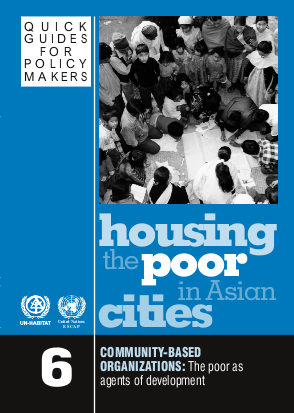
The emergence of community organizations of the poor in Asia has been a very important development during the past two decades. As structures which allow poor households and poor communities to move from isolation and powerlessness into collective strength, these organizations have become powerful development mechanisms in their countries — and they belong entirely to people. Besides providing a means of idea-sharing, asset-pooling and mutual support, community organizations create channels for poor people to talk to their local and national governments and to undertake collaborative development projects in housing, upgrading, land tenure, infrastructure and livelihood. Asia’s poor communities are increasingly delivering housing and community improvements, in collaboration with other development stakeholders. Community organizations can be valuable and resourceful partners when it comes to finding viable housing solutions for the poor. Community organizations must play a central role in finding solutions to their own housing problems. Understanding how they develop, how they function and what tools they use is of great value to policy makers, especially in the context of increasing decentralization. This guide introduces these aspects of Asia’s community organizations. This guide is not aimed at specialists, but aims to help build the capacities of national and local government officials and policy makers who need to quickly enhance their understanding of low-income housing issues.
Resource collections
- Locally led humanitarian action
- Topics
- UN Habitat - Urban Response Collection
- Urban Response - Urban Crisis Preparedness and Risk Reduction
- Urban Response Collection - Community Engagement and Social Cohesion
- Urban Response Collection - Economic Recovery
- Urban Response Collection - Environment and Climate Change
- Urban Response Collection - Housing, Land and Property
- Urban Response Collection - Urban Crisis Response, Recovery and Reconstruction
- Urban Response Collection - Urban Resilience
